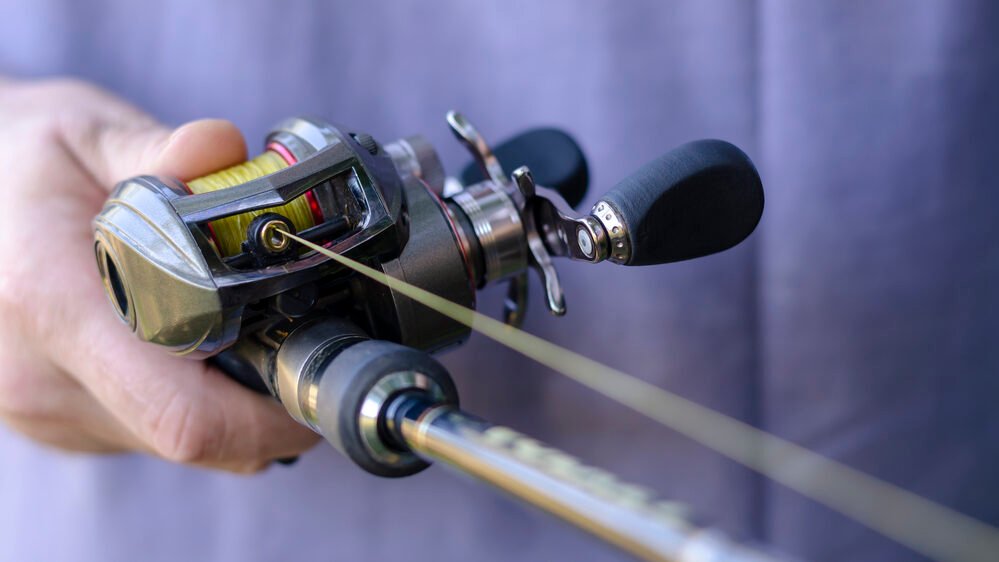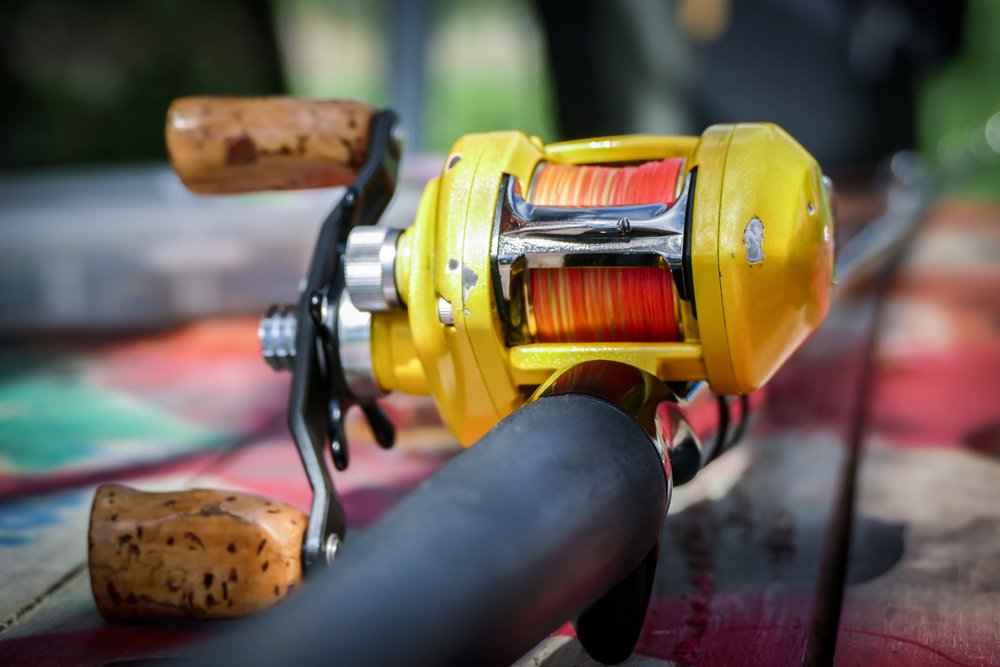How To Put Fishing Line on a Baitcasting Reel
Are you ready to spool your baitcasting reel like a pro and impress all your fishing buddies? Well, buckle up because this is going to be one wild ride!
Once you learn how to put fishing line on a baitcasting reel properly, you will take your fishing game to new heights (or depths, if you prefer)
Let’s be honest; spooling a baitcaster can be frustrating, especially if you are clueless about what you are doing. I’ve tried doing stuff I don’t know anything about, and let me tell you, it feels like trying to thread a needle in a hurricane.
But fear not, dear reader, because we’re here to guide you through the process completely stress-free. So grab a cold drink, kick back, and let’s get spooling!
What is a baitcasting reel?

Do you know those dainty and fickle spinning reels that can barely handle a minnow, much less a giant bass? Well, give that cute toy to the garbage collector. Upgrade to a baitcasting reel like the heavyweight champs of the fishing world. If you want to last 12 rounds in the water, you need real reels!
A baitcasting reel is a type of reel that uses a spool revolving around an axis, which allows you longer and more precise casting distance. It’s the go-to choice for many professional and seasoned anglers, but it can also be an excellent option for beginners with a bit of practice.
So what’s the difference between a baitcasting reel, spinning reels, fly reels, and other fancy reels? Let’s compare them quickly.
Spinning reels use a spinning spool attached to a handle and operated by your thumb. The advantage is that it’s easy to use and works great for light bait and small fish.
Fly reels are specifically designed for fly fishing, and they have a large round spool attached to the rod and use a fly line.
Baitcasting reels are more accurate and allow you to cast longer distances, reaching those hard-to-reach spots where the big fish are hiding. They can handle heavy lures and reel in larger fish without breaking, and you can use them in a wide range of conditions and fish species. Plus, using a baitcaster, you’ll have more precision and feel more in control, which is critical when you have an unyielding fish pulling at the other end of the line.
There is a bit of a learning curve to use a baitcaster reel, but it is worth the effort for anyone who wants to catch more than mere sardines.
Preparing to Spool Your Baitcasting Reel

Are you ready to spool your baitcasting reel? Great, let’s get started!
First, gather all the necessary materials: fishing line (braided, monofilament, or fluorocarbon), scissors, and backing (optional).
Pick the correct type of fishing line for your needs by considering factors such as strength, sensitivity, visibility, and casting distance. You then choose the proper amount of line to spool onto your reel, which depends on the manufacturer’s guidelines, your fishing style, technique, and the type of fish you are targeting. Don’t forget to leave space on the spool for proper line tension and to prevent overfilling.
If you’re using a braided line, you can soak it before spooling, as it improves its handling and knot strength, making it easier to work with and less prone to breaking. Fill a bucket with water and let the line soak for about 15-30 minutes before spooling. This step is optional but can be especially helpful for braided lines.
Now that you have all your materials ready, it’s time to get spooling!
Spooling the Fishing Line onto the Baitcasting Reel
Now that you have all your materials ready and your line soaked (if applicable), it’s time to get spooling! Don’t worry; with our step-by-step line guide, it will be much easier than trying to solve a Rubik’s Cube blindfolded.
A step-by-step guide to spooling a fishing line onto a baitcasting fishing reel:
- Tie the line to the spool using a suitable knot, such as a double uni knot or an arbor knot. Make sure the knot is secure and won’t slip or come undone.
- Attach the spool to the reel and ensure it is adequately secured. Refer to the manufacturer’s instructions for specific guidance.
- Begin spooling the line onto the reel, following the manufacturer’s instructions. Pay attention to line tension and spool evenly to prevent tangles, backlash, and line breaks.
- If desired, you can use a line spooling device to help distribute the line around the reel evenly and reduce finger pain and fatigue. This is especially helpful if you’re spooling a very long line.
- You can also consider using backing to fill around the spool and provide a smoother surface for the line to lay on. This can help reduce friction and improve casting distance.
- Finally, ensure to wind the line onto the spool in the direction recommended by the manufacturer, typically clockwise or counterclockwise. This will help prevent line twists and tangles.
And that’s it! Spooling your baitcasting reel will become second nature with a little bit of practice. Just remember to take your time, pay attention to line tension, and spool evenly to ensure a smooth and successful fishing experience.
Baitcaster Finishing Touches and Maintenance

You did it! You can pat yourself on the back as your baitcaster reel is spooled.
Now it’s time to test it by hitting the water. Let’s take a look at a few maintenance steps to make sure it lasts:
- Trim any excess line and secure the end with a knot, such as a double overhand knot or a nail knot. This will help prevent the line from unraveling or getting caught on something.
- Check for any tangles or knots in the line. These can be annoying and potentially damaging to your reel, so it’s best to remove them before you start fishing.
- If desired, you can use a leader to improve knot strength and prevent the fishing line from being visible to the fish. A leader is a separate line attached to the end of your main line and serves as a buffer between the two.
- Remember to maintain your reel by cleaning and lubricating it as needed. This is especially important after each fishing trip, as saltwater and dirt can corrode and wear down your reel over time. Refer to the manufacturer’s instructions for specific guidance on how to care for your reel.
By following these steps, you’ll be able to enjoy a smooth baitcaster that won’t give you headaches.
Troubleshooting Common Issues
Despite your best efforts, you may still encounter issues when using your baitcasting reel. Here are other common problems with baitcasters and how to troubleshoot them:
- Baitcaster not spooling evenly: If you’re having trouble getting the line to spool evenly, it could be due to improper line tension, a damaged spool, or worn bearings. Try adjusting the brake system or using a different spool tension setting to see if that helps.
- Line breaking or tangling frequently: If you’re experiencing constant line breaks or tangles, it could be due to improper line capacity, incorrect casting technique, or a damaged line. Try using a different type or brand of line or adjusting the brake system to see if that helps.
By identifying and addressing these issues, you’ll be able to get the most out of your baitcasting reel and have a more enjoyable fishing experience.
Frequently Asked Questions
Do I need to use backing with a braided line on a baitcasting reel?

No, you don’t need to use backing with a braided line on a baitcasting reel, but it can give advantages, such as filling the spool, smoothing the surface for the line to lay on, reducing friction, and improving casting distance. It also gives you more protection if the line breaks, and you can continue fishing until you have the time to re-spool.
What is the easiest line to use on a baitcasting reel?

Beginners will find the monofilament line the easiest line on a baitcaster. Mono is cheap, can be bought anywhere, and is easy to spool. The strength and sensitivity are good, but other line types are also suitable for baitcasting. It comes down to what you prefer to use, your needs, and what fish you’re after.
Why do pros use baitcasting reels?

The professionals use baitcasting reels for their advantages: higher accuracy, more control, better technique, longer casting distance, holding heavy lures, and pulling larger fish. Not using a baitcaster will give them quite a disadvantage in fishing competitions.

